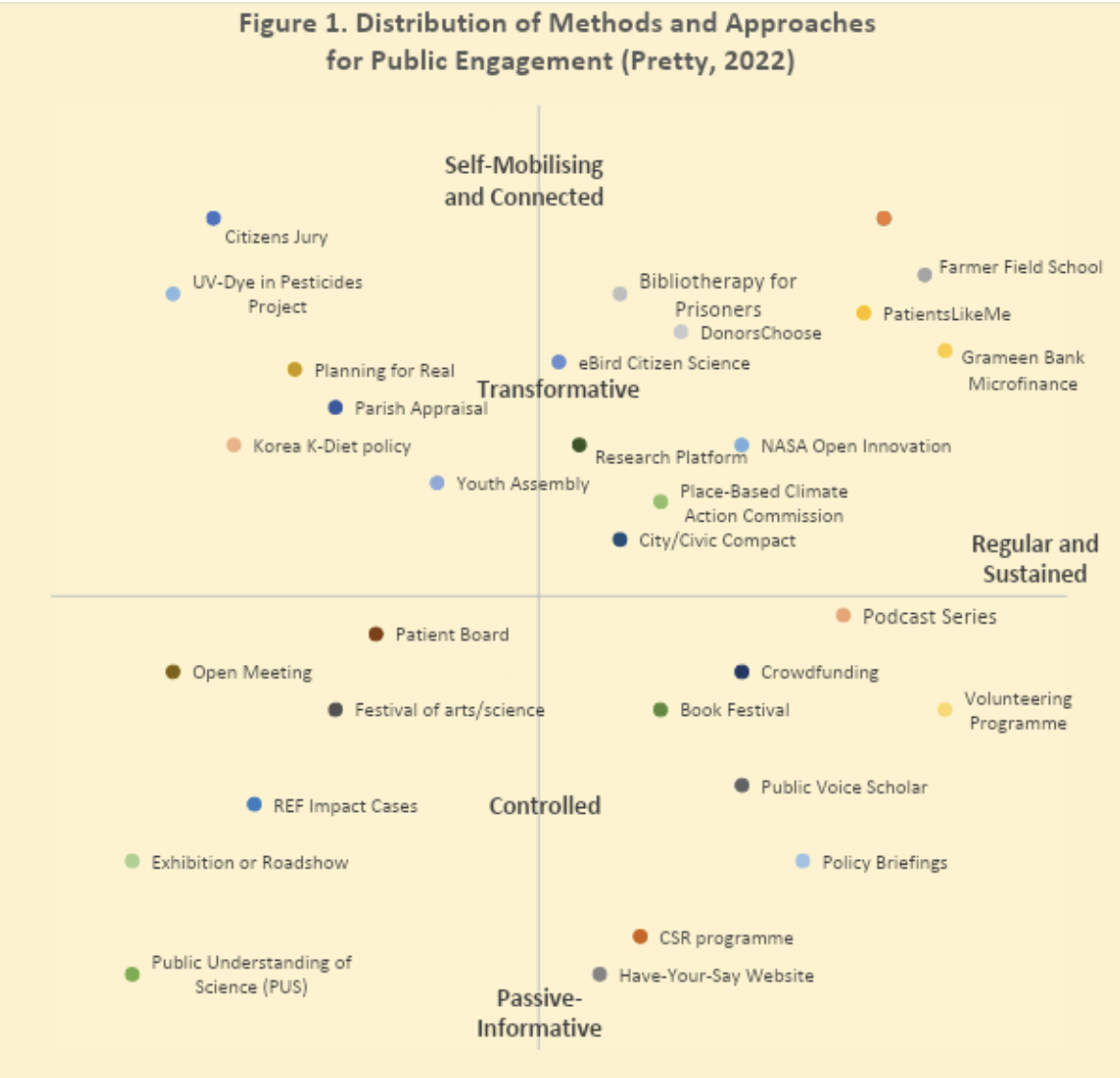Can Public Engagement Improve Lives?

Types of public engagement matter if we wish to improve lives
The purpose of Public Engagement (PE) in universities is to ensure research and education leads to improvements in people’s lives. An engaged university helps to transform social and ecological systems, has a high national and international profile and helps shape societal values on higher education. Public engagement is a term that is widely used in a variety of sectors, from policy and local government to arts and heritage, and the National Coordinating Centre for Public Engagement defines PE as "The myriad ways in which the activity and benefits of higher education and research can be shared with the public.” The Chief Executive of UKRI, Ottoline Leyser added in 2020: “We need to shift the whole concept of what the research and innovation system is and how it should work.” PE is likely to play a key role in this shift.
Many higher education institutions already have a variety of programmes and structures for public engagement, including centres and collectives, citizen-science projects, and local to international partnerships. And we have seen a wide range of corporate terminology emerge: being of service to society, being open and publicly-engaged, focusing on transforming lives, being an anchor organisation, expressing civic responsibility, committing to public voice, being permeable, and playing a formal role in city and civic futures.
It has been well-established over the past 30-40 years that there is a considerable participation premium. Public and private organisations who reach out to engage with their customers, consumers and members, with their staff and students, and with wider public groups, all find that people want to engage, they have something interesting to contribute in the form of time and money, and they enjoy being creative and contributing to a greater good. By contrast, they do not appreciate forms of “we-washing” or manipulation of engagement for the sole aims of external organisations.
To be most effective, PE requires the giving up of some power, and the accepting of the inherent value of multiple knowledges and viewpoints within particular systems and cultures. PE thus involves, at its best, thinking about new forms of power and relationships, and building a creative understanding of the crowd. In their book, #newpower, Henry Timms and Jeremy Heimans note that “A movement is not a movement unless it moves without you.”
This is the thing. Public engagement is not easy. It means giving up some existing status and power, often acquired after many years of training and learning knowledge and norms. It means valuing the knowledge and understandings of all people in a system. This can be especially hard when years of training have emphasised a mode of knowledge and technology transfer from those who know to those who do not, often called the deficit-model.
Types of Public Engagement
Public engagement is a multi-dimensional concept incorporating communication, co-creation, dialogue and the creation of social capital. Its deployment and methods and approaches have differed widely, representing variations in values and principles. The first typology to express these variations was the “ladder of participation” by Sherry Arnstein in 1969. Some 25 years later, I published in World Development a typology of participation for rural development programmes in Africa, Asia and Latin America, and since then there have been insightful contributions from Carissa Slotterbach, Kim Johnson and Anne Lane, Muki Haklay, Rasmus Nielsen and many more.
All seek to indicate there is a spectrum from passive PE (people are told what has been decided) to consultative modes (people are asked set questions), to collective and interactive (people work together in joint analysis), to transformative (where the worldviews and behaviours of all actors change), and finally to self-mobilising and connected (citizens take action independently of external institutions). In Figure 1, I have mapped the locations of some 30 applications of PE along two scales: from single event to regular and sustained action; and from Passive-Informative to Self-Mobilising and Connected. 
The way to look at this PE typology is not that these types are mutually incompatible, nor that one is inherently best (or worst). One type may lead to another. It may be that engagement starts with communication, leads to development of an audience, which then produces transformative engagement. This escalator approach can allow for the building of confidence of actors.
This typology is designed to provoke reflection, cause us to think about methods and outcomes, and not to be satisfied with supply-led pushing of information. For universities: this is how we will engage to make changes you will consider as improvements.
Jules Pretty is Professor of Environment and Society at the University of Essex, and Director of the Centre for Public and Policy Engagement. He is former deputy chair of a government scientific advisory committee, and has served on advisory committees for research councils, the Royal Society, and the government office for science. He is an award-winning author, and host of the podcast, Louder Than Words.










































































































